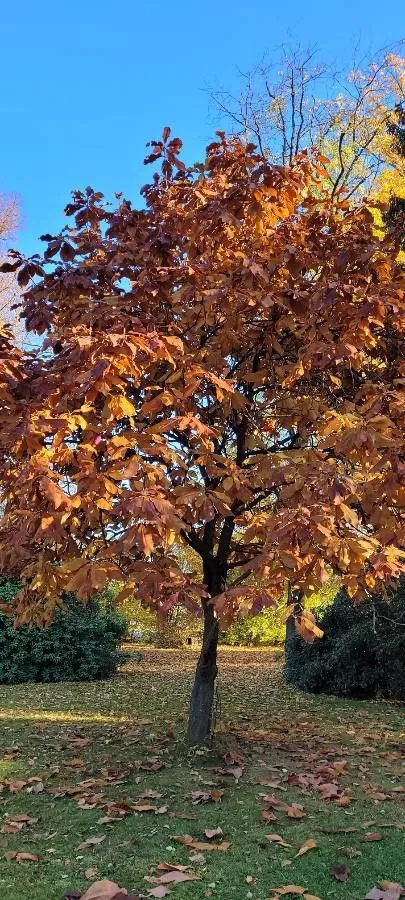
Author: Michx.
Bibliography: Fl. Bor.-Amer. 1: 327 (1803)
Year: 1803
Status: accepted
Rank: species
Genus: Magnolia
Vegetable: False
Observations: Ohio to SE. U.S.A.
Big-leaf magnolia, scientifically known as Magnolia macrophylla, is a remarkable species recognized for its truly magnificent foliage. Originally documented in 1803 by Michx. in Fl. Bor.-Amer., this plant stands out as one of the most striking members of the Magnoliaceae family due to its colossal leaves and substantial ornamental appeal.
The native range of the Big-leaf magnolia extends from Ohio through the southeastern regions of the United States. Here, it thrives in moist, well-drained soils typically found in rich, deciduous forests and along the edges of streams.
What undeniably sets the Big-leaf magnolia apart is its leaves: they are among the largest of any temperate tree, often reaching up to 30 inches in length and 10-12 inches in width. These titanic leaves create a lush, tropical appearance, contributing both shade and beauty to the landscapes they inhabit. In addition to their impressive size, the leaves display a deep green color on the upper surface, while the underside reveals a lighter, silvery tone, adding to their visual allure.
The Big-leaf magnolia also produces large, creamy-white flowers that can span up to 12 inches in diameter. These blooms typically appear in late spring to early summer, offering a spectacular floral display that compliments the exceptional foliage. The fragrant flowers are followed by curious, cucumber-shaped fruit cones that provide additional interest throughout the growing season.
This species not only serves as an attractive ornamental tree but also plays a crucial ecological role. It supports various wildlife, including pollinators like bees, which are drawn to the sizable blooms. Birds and small mammals may also benefit from the shelter and food resources provided by this splendid magnolia.
In landscape design, Magnolia macrophylla can be used as a standalone specimen tree where its large size and unique characteristics can be showcased. Due to its need for space to fully develop, it’s most suitably planted in large gardens or park settings.
Overall, the Big-leaf magnolia is a majestic plant that commands attention and admiration wherever it is found. Its grandeur, coupled with ecological benefits, make it a valuable addition to both natural and designed landscapes.
Eng: big-leaf magnolia, bigleaf magnolia, large-leaf cucumber-tree, umbrella-tree
Swe: storbladig magnolia
En: Big-leaf magnolia, Large-leaf cucumber-tree, Umbrella-tree, Bigleaf magnolia, Large leaf magnolia
Ar: ماغنوليا كبيرة الأوراق
Bg: Едролистна магнолия
Cs: Šácholan velkolistý
Fi: Isolehtimagnolia
De: Großblättrige Magnolie
Hu: Nagylevelű liliomfa
Ru: Магнолия крупнолистная
Sv: Storbladig magnolia
Taken May 17, 2020 by Roberto Tulipani (cc-by-sa)
Taken May 25, 2022 by Cécile (cc-by-sa)
Taken Oct 1, 2021 by Calvin Jonas (cc-by-sa)
Taken Oct 28, 2021 by Martin (cc-by-sa)
Taken Oct 28, 2021 by Martin (cc-by-sa)
Taken Oct 1, 2019 by ming fu (cc-by-sa)
Taken Oct 17, 2022 by William Coville (cc-by-sa)
Taken Sep 7, 2020 by Kampf Robert (cc-by-sa)
Taken Aug 29, 2020 by Philippe de Spoelberch (cc-by-sa)
Taken Oct 28, 2021 by Martin (cc-by-sa)
Taken Aug 29, 2020 by Philippe de Spoelberch (cc-by-sa)
Taken Sep 7, 2020 by Kampf Robert (cc-by-sa)
Taken Sep 18, 2021 by kodl (cc-by-sa)
Taken Aug 9, 2021 by pernambucojurema (cc-by-sa)
Taken Oct 28, 2021 by Martin (cc-by-sa)
Taken May 17, 2020 by S.Marinkov (cc-by-sa)
Taken May 17, 2020 by Roberto Tulipani (cc-by-sa)
Taken Jun 30, 2019 by CJ CJ (cc-by-sa)
Taken Jul 9, 2019 by ekinox53 (cc-by-sa)
Taken Jun 2, 2018 by Juan Haro (cc-by-sa)
Taken Jun 19, 2021 by Malte (cc-by-sa)
Taken Oct 28, 2022 by Liz Anderson (cc-by-sa)
Taken Jul 22, 2022 by William Coville (cc-by-sa)
Taken Oct 1, 2021 by Calvin Jonas (cc-by-sa)
Taken Oct 14, 2019 by Eli Small (cc-by-sa)
Taken May 12, 2019 by Eli Small (cc-by-sa)
Taken May 21, 2020 by Pasak Ewa (cc-by-sa)
Growth habit>: Tree
Family: Myrtaceae Author: (F.Muell.) K.D.Hill & L.A.S.Johnson Bibliography: Telopea 6: 402 (1995) Year: 1995 Status:…
Family: Rubiaceae Author: Pierre ex A.Froehner Bibliography: Notizbl. Bot. Gart. Berlin-Dahlem 1: 237 (1897) Year:…
Family: Sapindaceae Author: Koidz. Bibliography: J. Coll. Sci. Imp. Univ. Tokyo 32(1): 38 (1911) Year:…
Family: Asteraceae Author: A.Gray Bibliography: Pacif. Railr. Rep.: 107 (1857) Year: 1857 Status: accepted Rank:…
Family: Fabaceae Author: Medik. Bibliography: Vorles. Churpfälz. Phys.-Ökon. Ges. 2: 398 (1787) Year: 1787 Status:…
Family: Aspleniaceae Author: (Cav.) Alston Bibliography: Bull. Misc. Inform. Kew 1932: 309 (1932) Year: 1932…